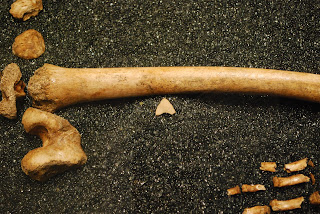
There aren’t many people in the world that can call themselves forensic anthropologists. Most of us are familiar with the word forensics from TV shows like CSI Miami. CSI agents gather evidence from a crime scene and use science to solve mysteries that lead to arrests. A forensic anthropologist uses his or her knowledge of the human skeleton to solve mysteries involving skeletal remains that have partially decomposed or have been rendered unrecognizable to the untrained eye. Forensic anthropologists often assist with solving crimes that involve human remains, but they are also invaluable to archaeological excavations.
One such archaeological excavation has been taking place in Jamestown, Virginia. Jamestown is known as the first permanent English Settlement in what we call the United States today. Jamestown was established in 1607, but until recently, the original site of the James Fort was believed to have washed away because of the James River. The Jamestown Rediscovery Project hit pay-dirt in the 1990s when they found evidence of the original fort, remains of houses, and the graves of many of the early settlers to Jamestown.
Many of the graves rediscovered contained mysteries for forensic anthropologists to solve. They were mysteries only the skeletons of those who were buried could answer. Questions such as: Who were these early settlers? What was life like for them at Jamestown? And, how did they die?
A highly unusual grave discovered was found to be the skeleton of male teenager.

Forensic anthropologists carefully uncovered possible evidence suggesting how the teenaged boy died.

The trauma of an arrow hitting the boy in leg in the area of his femur may have been the incident that brought on his death. On further investigation, forensic scientists believe this may have been a blessing. The young man was probably living a life in agony before he was shot. Forensic anthropologists took a look at his teeth and determined that he had been suffering from an infection that started from a broken abscessed tooth and then the infection had spread. Without modern dentistry and medicines, a fairly routine problem today was fatal back then in 1607.

Using the techniques of facial reconstruction this may resemble what the boy looked like before he died.

For more information about the Jamestown Rediscovery Project go to:
Virtual Jamestown
For a fiction connection, take a look at Blood on the River by Elisa Carbone
Check out other popular titles by Sally M. Walker such as:











